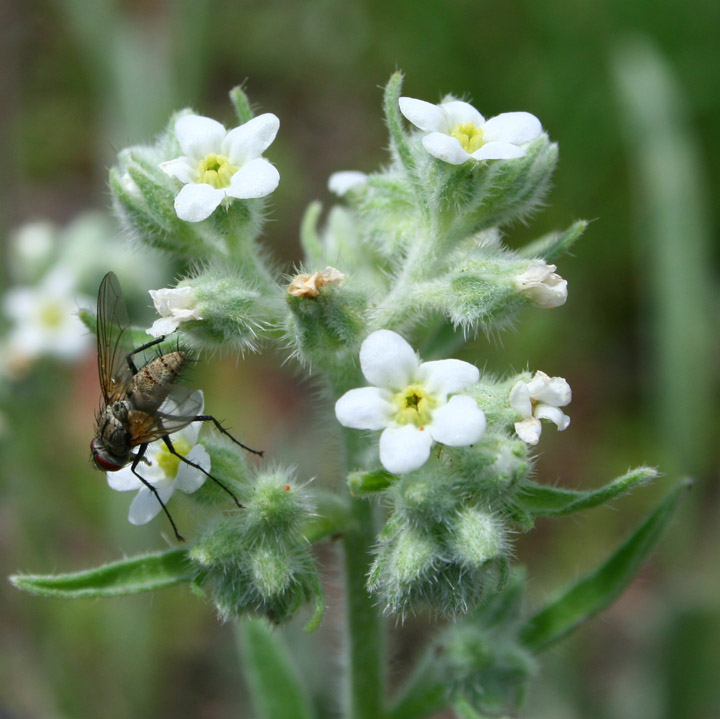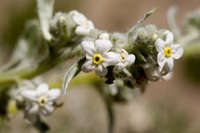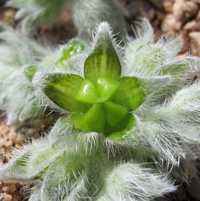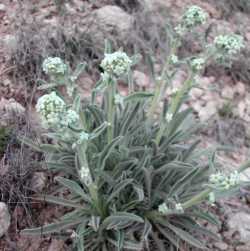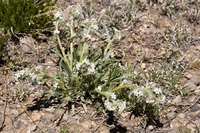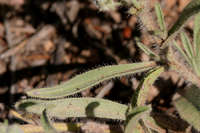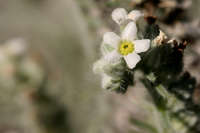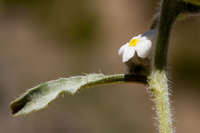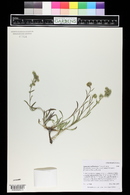|
Family: Boraginaceae
James' cryptantha, more...James' cryptantha [ Cryptantha cinerea (Greene) A. Cronquist, moreCryptantha cinerea var. cinerea , Cryptantha jamesii var. cinerea (Greene) Payson, Cryptantha jamesii var. multicaulis (Greene) Payson, Cryptantha jamesii var. setosa (M.E. Jones) I.M. Johnst. ex Tidestr.] |
Jepson 1993, Kearney and Peebles 1969, Sivinski 1998, Welsh et al 2003 Duration: Perennial Nativity: Native Lifeform: Subshrub General: Perennial herbs, to 20 cm tall, from a woody caudex, this sometimes branched; stems prostrate to ascending, branching from the base as well as above; herbage silvery-white in appearance, covered with long hairs and stiff white bristles, these bulbous at the base (pustulate). Leaves: Clustered in a persistent basal rosette and alternate along the stems, sessile; blades linear to oblanceolate, 1-9 cm long, upper surfaces strigose, lower surfaces strigose and bristly. Flowers: White and yellow, in scorpioid cymes that become elongate in fruit; calyx 5 parted, the lobes ovate-lanceolate, 3-4 mm long in flower, 5-6 mm long in fruit; corollas salverform, white with a yellow throat, the tubes ringed with short antrorse scales at the base of the interior. Fruits: Nutlets 1-4 per calyx, smooth and shiny, 2 mm long, curved inward, not compressed. Ecology: Found on dry, sandy or gravelly soils in open, grassy woodlands, often among pi-on-juniper and oak, from 4,500-8,500 ft (1372-2591 m); flowers April-September. Distribution: MT to CA, east to TX. Notes: Cryptantha is a genus of bristly herbs with white or yellow flowers in spikes that are usually 1-sided and curling like a scorpion-s tail (-scorpioid-). C. cinerea is a common perennial Cryptantha, fairly widespread in the West. Look for basal clusters of bristly lanceolate leaves with a few flowering stalks emerging from within; each stalk with several scorpioid cymes of white flowers with yellow centers. The seeds (nutlets) are smooth and shiny. There are a number of varieties, some of which have at times been treated as separate species. Ethnobotany: The plant was given to newborn infants for prenatal snake or toad infection; a poultice of the plant was applied to snakebites and sores; also used ceremonially as a life medicine. Etymology: Cryptantha comes from the Greek krypto, "hidden," and anthos, "flower," a reference to the first described species in the genus which has inconspicuous flowers that self-fertilize without opening; cinera means ashy-gray, referring to the foliage. Synonyms: None Editor: LCrumbacher 2011, AHazelton 2015 |

